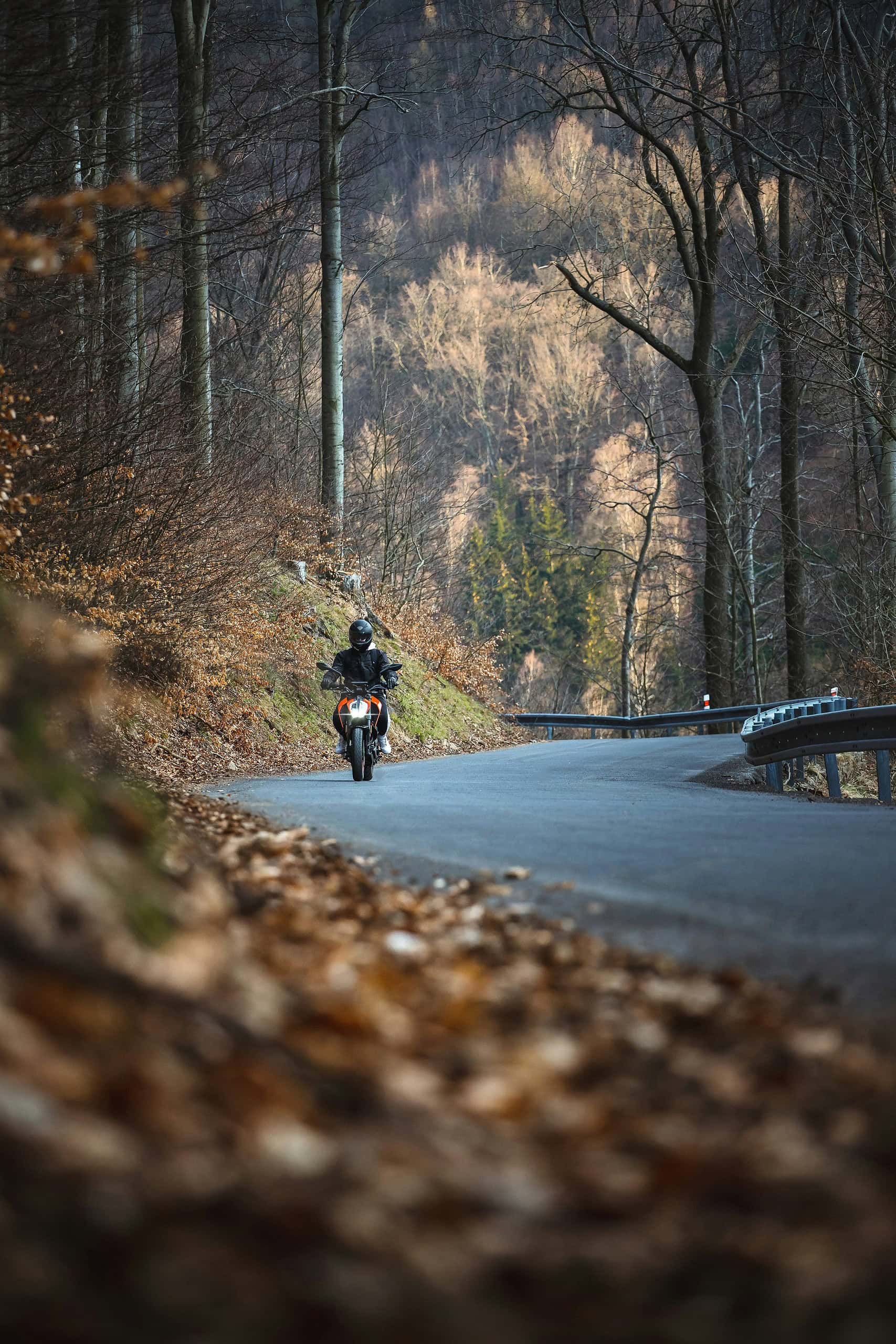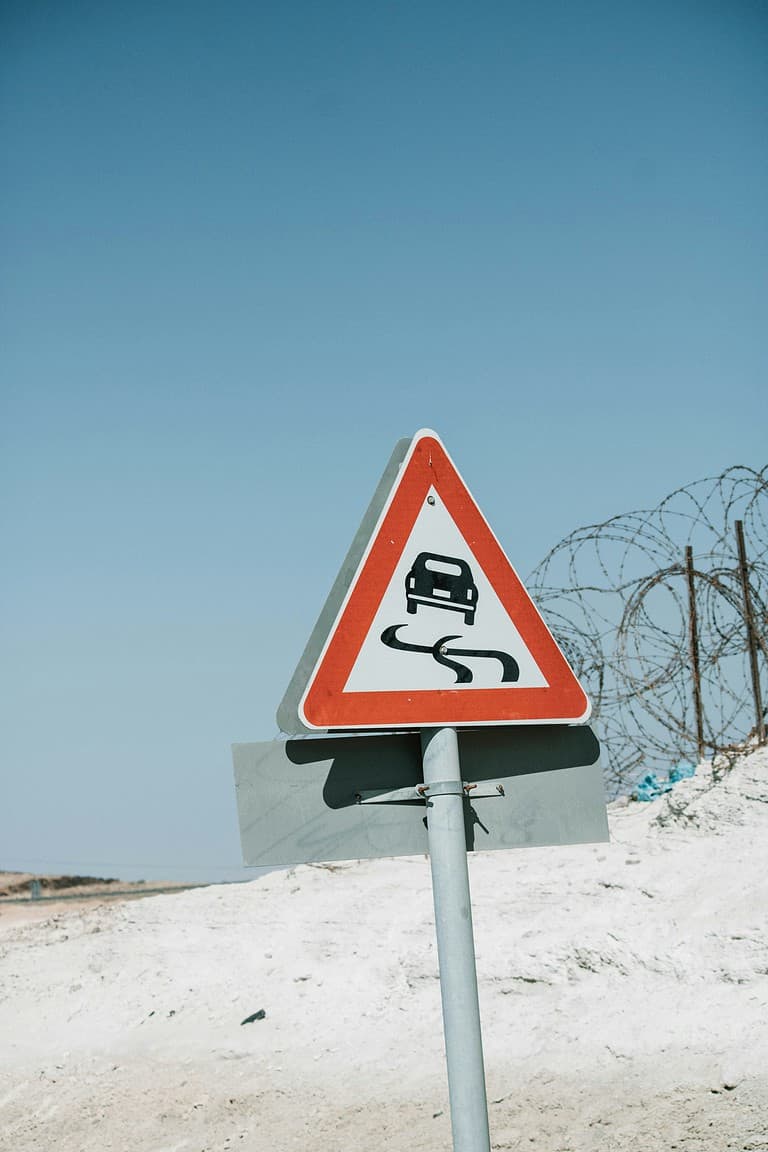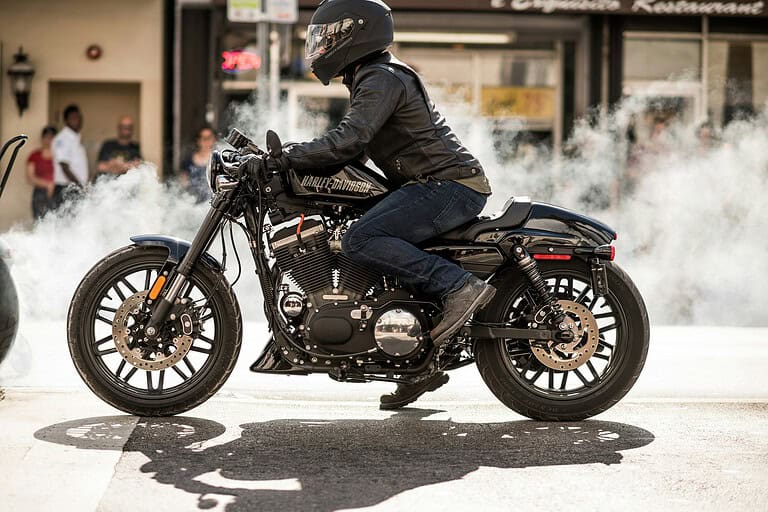13 Motorcycle Safety Tips (For Beginner Riders)
As a beginner motorcycle rider, you might feel a mix of excitement and anxiety about hitting the open road. The thrill of riding can quickly turn into fear and uncertainty when it comes to keeping yourself safe. Many new riders face this challenge, and it’s entirely normal. The good news is, you’re not alone, and I’ve put together a list to ensure a safer riding experience.
The picture of cruising down the road, wind whipping past you on two wheels is every motorcyclist’s dream. But we also are at risk on the road as riders: we’re hard to see relative to a car and are more at risk in general.
After taking a motorcycle safety course, it can be a little daunting starting on your own on the road. The list of motorcycle safety tips I’ve included will help give you a base foundation of best practices and get you feeling more confident on the road as you gain experience. Let’s get into it.
What is Motorcycle Safety?
The concept of motorcycle safety seems self-explanatory, doesn’t it? Most would say that motorcycle safety is pretty much synonymous with motorcycle gear; but safety is a lot more than just wearing proper gear. Motorcycle safety includes everything from maintenance, to road skills, to road awareness.
Why is Motorcycle Safety Important for Beginner Riders?
When I first started riding, I didn’t have anyone to help with the development of my skills. There was no online guide, and none of my friends had a motorcycle (at least, not at the time). And despite taking a motorcycle safety course, that hardly prepared me in the way that more miles and experience did.
In the below list, you’ll find the things I wish someone had told me when I first started riding. Overall the goal at RideCaffeinated is to do just that: be your virtual riding companion, helping you build up your skills and knowledge base so that you can enjoy motorcycling safely for many years to come.

13 Motorcycle Safety Tips (For Beginner Riders)
If you’re just starting out, yes, the Motorcycle Safety Training courses are a great way to build some basic knowledge and skills, but some things can’t be taught in a parking lot and may take some riding experience to learn.
So while some of the items below are somewhat common sense (and along the lines of what you might find in a basic rider course), some are learned from my personal motorcycle experience, organized in order of what you need to get ready before walking out the door, all the way to enjoying the tarmac with other motorcycle riders.
1. Wear Your Gear
It’s common sense, but I had to include it. It’s pretty common to see beginners that factor the cost of the first bike in but don’t bankroll much for adding gear to their collection. I totally understand – the bike can be expensive, but seeing as how there are no walls around your bike, do yourself a favor and get yourself the proper gear. Trust me; a slide at even just 20mph can open plenty of skin.
And if you’re that person that says, ‘Oh, I’m planning to just buy more gear later’, well, how often does that actually happen? I know you’re eyeing that new exhaust can instead…
Given that a large number of states mandate a motorcycle helmet, that’s a great place to start, but I’d highly recommend at least one jacket, a pair of gloves, and a pair of boots or riding shoes.
So go ahead and pull the trigger on that gear now; literally, ANYTHING designed for a motorcycle will be better than just a T-shirt.
2. Do Your T-CLOCs
Getting to know your bike and knowing that it’s working in good condition is a great habit to build before you go out on the road. The acronym T-CLOCs stands for:
- Tires and Wheels
- Controls
- Lights and Electronics
- Oil and Other Fluids
- Chassis
- Stands.
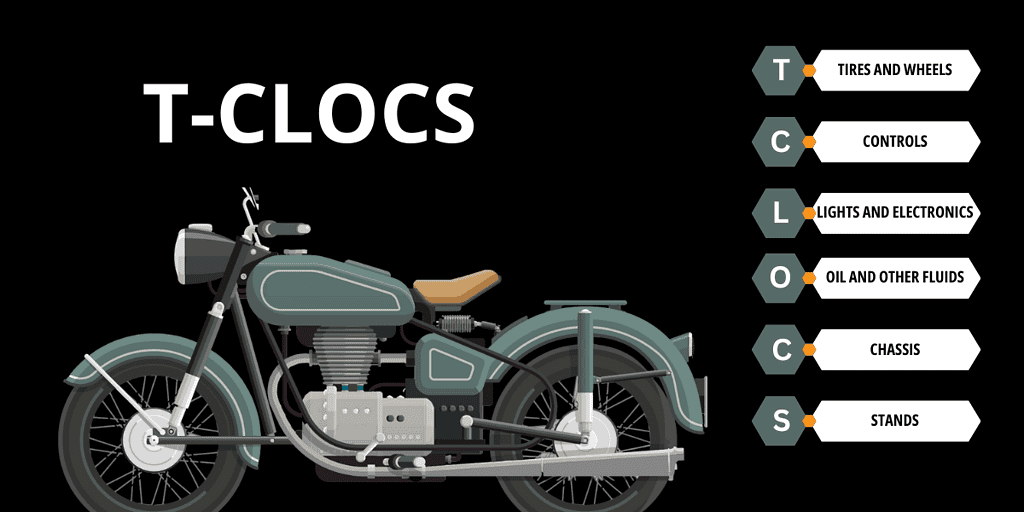
Each of these is essential to the basic operation of your motorcycle and should be checked regularly to ensure they’re working well. A pre-ride inspection is recommended by pretty much every rider safety group, and experienced riders can certainly vouch for the fact that you’ll randomly come across other potential risks during those few minutes of pre-ride inspection.
Just think; you can do your checks while you’re letting your bike warm up before you take off.
3. Invest In Ear Plugs
Ear plugs aren’t what you might first think of when it comes to having a set of proper gear, but I can tell you they’ve become an essential part of my kit for every single ride.
I’ve tried quite a few different versions, and lately, I’ve been using a set of Loop earplugs. They offer the same level of customizability that other brands do, meaning that you can swap out parts and pieces, and allow me to hear ambient noise (like sirens of emergency vehicles) but still protect my hearing loss at the same time.
As someone who loves to blast their music in headphones, and did so a lot when I was a kid, I can tell you my hearing isn’t nearly as great as it once was, but I want to make sure that it doesn’t get any worse than it already is.
4. Do Your Chain Maintenance
If I had a dollar for every time my shop reminded me that I need to clean my chain more often, I’d be a pretty rich man.
Chain maintenance is more than just cleaning it, however. While cleaning, you should be checking for any worn-out components or kinks. The weakest point is an opportunity for failure, and that is a failure that we do NOT want.
In case you weren’t aware, a kinked chain can easily get caught, and well, that’s going to be one abrupt motorcycle crash.
Don’t forget to check the chain tension every 500 or so miles, and make sure that it’s within spec. Chains naturally stretch over time. There IS such a thing as a too-tight chain, which will wear both the chain and your sprockets quicker, but the more common issue is a chain that is far too loose.
Oh, and if you do need to replace your chain, make sure you’re also replacing your sprockets at the same time.
5. Wash Your Bike
It’s not just about it looking good, even though a good shine on the paint never hurt anyone. Washing your bike is a chance for you to look over each part and component of your bike in detail. You might find lodged debris, loose screws, and sometimes even some stuck dead animals… (ask me how I know…)
For those of you who are year-round commuters (or planning to be) rain and dirt can get caked up all over the place, and a good wash is a chance to get the bike back to good performing condition as well.
Every once in a while, do yourself a favor and do a deep clean. Pull off some components like fairings and brakes and give everything in the depths of your bike a thorough clean. Again, it’s also a time to inspect the condition of everything “under the hood.”
I’ll be the first to admit I don’t wash my bike as much as I should, especially in the rainier seasons in Washington, and I’ve earned myself some stubborn water spots as a result. Don’t be like me!
6. Adjust Your Following Distance
On a motorcycle, traffic crashes can easily turn into traffic fatalities, and a following distance that is too close can easily exacerbate the risks.
As a rider too, I get it: cars are slow, annoying, and often in the way – looking at you, single-occupant-HOV-lane-campers…
But giving yourself enough space to react to the idiocy (read: unpredictability) of drivers on the road is a good thing. I’ve had some close calls where other vehicles have randomly slammed on the brakes, and I’m glad I had the extra space to be able to ensure I didn’t end up as a rear bumper ornament.
And at the end of the day, other drivers will probably appreciate it a bit too, giving us a better name as motorcycle riders.
7. Plan Your Exit
When I first started riding, planning my exit was something I was constantly doing. Adjusting lane positioning based on traffic, looking for wider shoulders, and finding open lanes where there was more room for me to breathe and not be boxed in with other traffic.
I don’t remember how it started, but for any rider, as soon as you have a few close calls, it’ll likely become somewhat second nature.
Wherever you’re riding, be it in the middle of a city, or out don’t the freeway, know what you’re going to do BEFORE you need to do it. What if that car pulls out in front of you? What if that truck starts merging into your lane? What happens if the tar snakes are more slippery than you anticipated?
Doing this will allow your mind to digest the problem and have a solution ready without even having to think or process it: it’ll just be muscle memory.
8. Head on a Swivel
This pretty much goes along with number 7 and planning your exit, because the more you’re aware of your surroundings, the more that you can plan for the potential unknowns on the road.
I used to play a game with myself while riding along; and tried to make sure that for any and every car that might pass me on the road, I had to see it before it passed me. And while it’s certainly important to keep attention on the road in front of you, if you know exactly where everyone is behind and around you, including their closing speed, it will give you SO many more options when moving around the road.
I’ve had a few friends start riding after I did, and I’ve gone out on rides with them, riding behind them to keep a more comfortable cushion around them. And I was constantly chatting in their ear via the Bluetooth comm: “Did you see that car coming? Did you see that truck merging in?” all just to make sure that they were constantly paying attention.
9. Plan for the Unexpected
Another tip that goes hand in hand with the last two; and that is planning for the unexpected. But in addition to all of the mental riding skills that will keep you aware on the road, there are other facets as well.
Motorcycle helmets: are you wearing a full-face one? If not; do you have a windscreen that is going to keep your face from earning some new craters if a car or truck kicks up a sizeable rock? (I’ve had these hit both my legs and arms, and can tell you, I do NOT want that in my face).
What about the weather? Are you riding over mountain passes? Are you ready for a 30-degree temperature drop? Are you ready if it starts pouring?
Even in the summer; the evenings out here in the PNW can get pretty cool – I’ve ridden home at 9 pm shivering because I was in lightweight perforated gear for the 80-degree day, but I didn’t plan for the temperature drop.
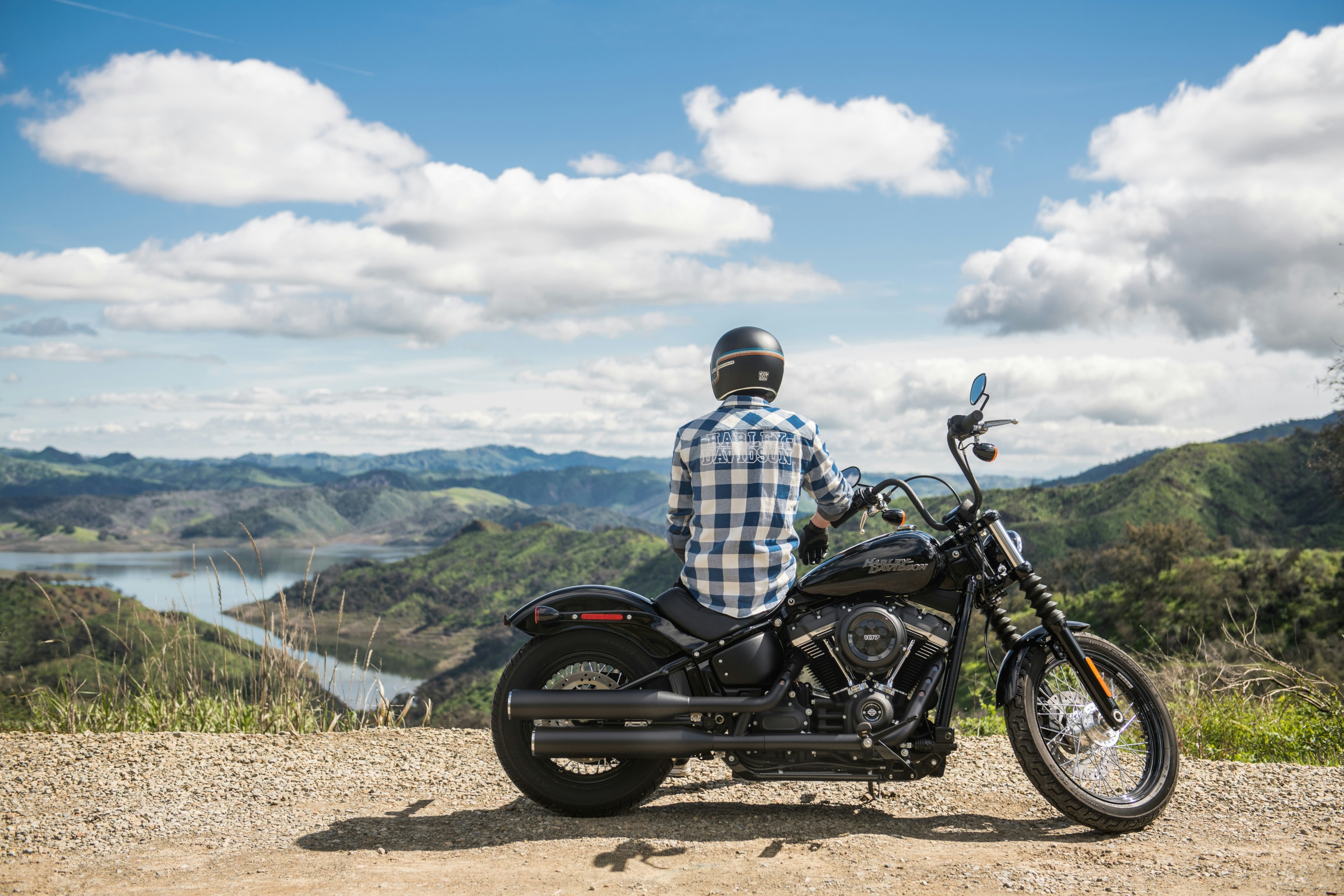
10. Leave Your Ego at the Door
There are a lot of… er… “strong personalities,” let’s say, in the motorcycle community. So when you’re first starting, it’s easy to understand why some new riders might get a little bit overwhelmed.
There’s also definitely that aspect of not wanting to look like a total newbie rider.
Let’s face it: every single one of us had to start somewhere. None of us crawled out of the womb with our motorcycle license and all the skills of a super-experienced rider. We had to start on a motorcycle from scratch; learning about basic operation, friction zone, shifting woes (damn you accidental neutral), group rides, and in general just getting more comfortable on the bike.
I can assure you, there is NO timeline or expectation that you have to meet. Take your time, wear proper gear, and practice your skills. As long as you continue to work on that, you’ll be one of the most experienced riders on the road over time.
And when it comes to those first group rides – I can’t stress enough; ride your own ride. If everyone leaves you in the dust, make it your own cruise and just get home safely.
11. Get Enough Sleep
Ever tried to do a long road trip, and you’re on about hour 8 of driving and you’re starting to get pretty fatigued at the wheel?
Well, motorcycles amplify that feeling tenfold. There’s no climate control, and no wind protection, the seats are not bucket seats, and your attention is being pulled in a lot of different directions.
As a result of all of that, you get tired a lot faster. I’ve had days in a car where I’ve driven 800 miles in a day. I personally start to get tired on a bike between 400 and 500 miles, and I need a lot more stops along the way, including a lot of extra electrolyte hydration.
Don’t push yourself any further than you need to. If you need to post up in a hotel for a night, do it. Or if you’re close to home, have a friend come pick you up. It’s not worth risking fatal crashes because you fell asleep at the handlebars.
12. Ride With a Friend
Some might argue that riding with a friend could mean that you might feel like you have to ride faster than your comfort level if riding with a more experienced rider. But that’s not the type of friend that I’m talking about here: I’m talking about a friend ( and likely just one) that you trust and won’t push you any further than you feel comfortable.
What I’d recommend is that they ride behind you to keep an eye on everything behind and around you. It will have a few benefits:
- You’ll get to focus your attention on all that’s in front of you
- You’ll get the chance to lead your own first little group ride
- They will be able to keep an eye on your habits and general tendencies and provide feedback.
A Bluetooth comm is a must for this! That way you can get real-time feedback.
Are you drifting in your part of the lane? Did you forget to cancel your signal? Are you riding too close to the car in front of you? Building good habits takes time, and a friend can help bring these things to light with friendly reminders as you build muscle memory.
13. Take It Slow (progression)
Give yourself a chance to develop the fundamental skills, starting with a basic rider course. Then, as you move from a novice rider to an advanced rider, don’t be afraid to take an intermediate or advanced rider course.
The Motorcycle Safety Foundation is just one of many outfits out there that can give you instructed time to build skills. It should go without saying that regular rider training can keep skills that you don’t often use fresh.

Key Considerations for Progression
This list is a great start for the novice rider, but it’s certainly not an all-encompassing list. If there’s one takeaway that is reflected through all of these tips, it’s that you have to continue practicing.
No one is an expert at the beginning.
Remember that your skills are only as good as the frequency with which you practice them. Even if you put in 10 hours in a weekend with swerves and emergency braking; your
Think of it like running: You could have a 6-minute mile in your pocket, but if you just stop running for three months, you won’t be able to run that time anymore.
Other Important Safety Considerations
When you’re out on the road, the biggest variable is other motorists. Cars, trucks, and other riders can all affect your safety on the road. Use your turn signals, avoid blind spots, and practice all the road safety that you can. Make it completely obvious what your intentions on the road are, and stay visible.
Make it a point to learn about your bike; get used to doing the basic maintenance and learn about how the bike works and what minor fixes you could do on the road.
Be prepared when you head out to ride! I can’t tell you how many times some duct tape and zip ties was enough to just get me to the next stop.
My Experience
When I first started riding motorcycles, I didn’t have anyone to help me learn or coach me. i did take the Motorcycle Safety Foundation Basic Rider Course through the local community college, and that got me through the absolute basics, but that was it.
It was nearly ten years afterward that I bought my first bike. It felt like every movement was clunky, nothing was smooth, and how the heck was I supposed to blip the throttle to downshift!? Most of my miles have been commuting, but riding with others, finding my community to ride with, and staying consistent with it has really helped me develop some great skills.
If you’re feeling frustrated with the process, take some solace in the fact that it simply takes some longer than others to get comfortable on a bike.
So that’s my story – one guy, several bikes, and thousands of miles on two wheels on the road. Wishing you the maximum smiles for miles, and always keeping the shiny side up!

